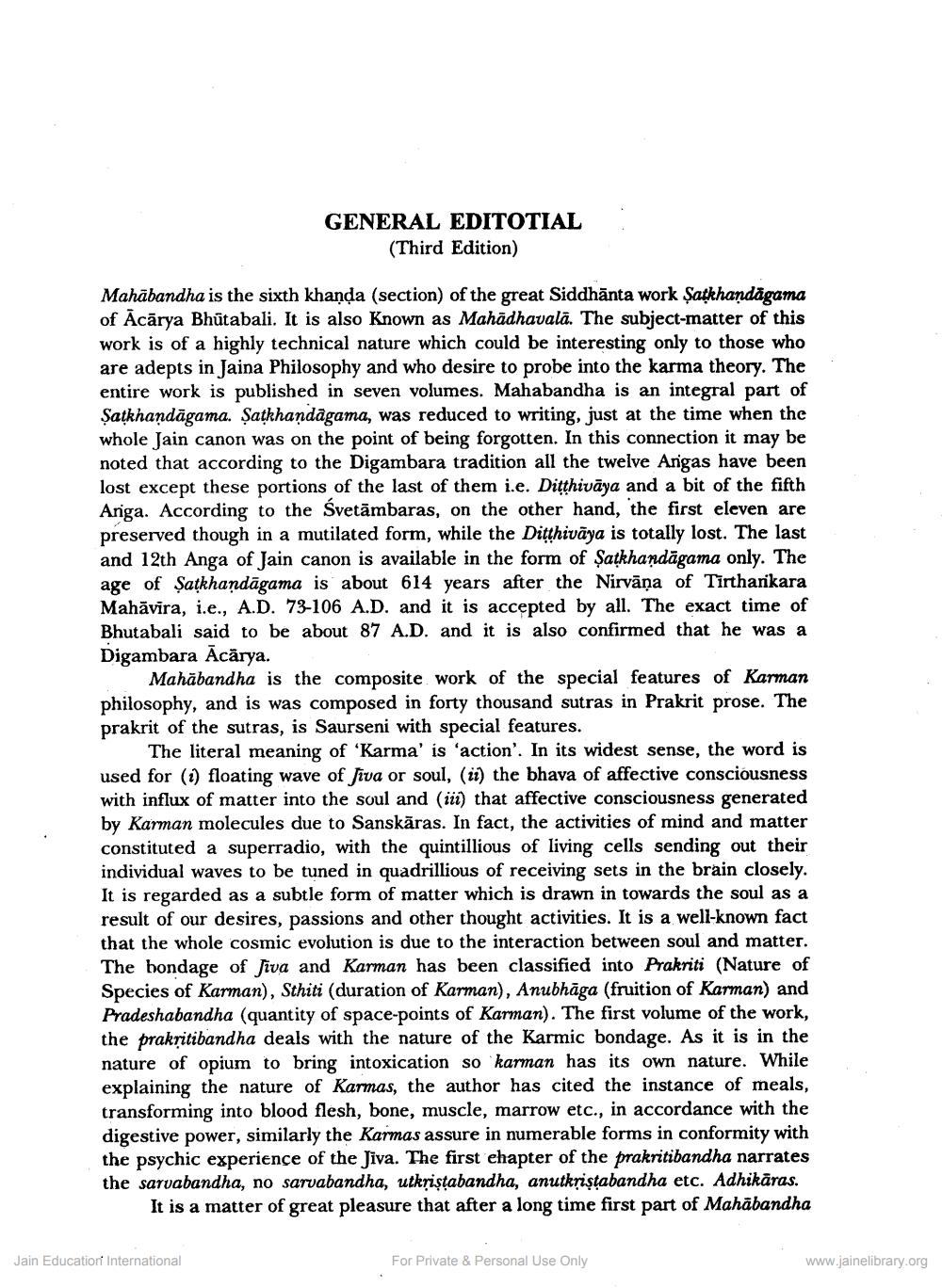________________
GENERAL EDITOTIAL
(Third Edition)
Mahābandha is the sixth khanda (section) of the great Siddhānta work Şarkhandägama of Acārya Bhūtabali. It is also known as Mahādhavala. The subject matter of this work is of a highly technical nature which could be interesting only to those who are adepts in Jaina Philosophy and who desire to probe into the karma theory. The entire work is published in seven volumes. Mahabandha is an integral part of Șatkhandāgama. Șatkhandāgama, was reduced to writing, just at the time when the whole Jain canon was on the point of being forgotten. In this connection it may be noted that according to the Digambara tradition all the twelve Angas have been lost except these portions of the last of them i.e. Ditthivāya and a bit of the fifth Anga. According to the Svetämbaras, on the other hand, the first eleven are preserved though in a mutilated form, while the Ditthivāya is totally lost. The last and 12th Anga of Jain canon is available in the form of Şatkhandāgama only. The age of Şatkhandāgama is about 614 years after the Nirvāņa of Tīrthanikara Mahāvira, i.e., A.D. 73-106 A.D. and it is accepted by all. The exact time of Bhutabali said to be about 87 A.D. and it is also confirmed that he was a Digambara Acārya.
Mahābandha is the composite work of the special features of Karman philosophy, and is was composed in forty thousand sutras in Prakrit prose. The prakrit of the sutras, is Saurseni with special features.
The literal meaning of 'Karma' is 'action'. In its widest sense, the word is used for (i) floating wave of Jiva or soul, (ii) the bhava of affective consciousness with influx of matter into the soul and (ii) that affective consciousness generated by Karman molecules due to Sanskāras. In fact, the activities of mind and matter constituted a superradio, with the quintillious of living cells sending out their individual waves to be tuned in quadrillious of receiving sets in the brain closely. It is regarded as a subtle form of matter which is drawn in towards the soul as a result of our desires, passions and other thought activities. It is a well-known fact that the whole cosmic evolution is due to the interaction between soul and matter. The bondage of Jiva and Karman has been classified into Prakriti (Nature of Species of Karman), Sthiti (duration of Karman), Anubhāga (fruition of Karman) and Pradeshabandha (quantity of space-points of Karman). The first volume of the work, the prakritibandha deals with the nature of the Karmic bondage. As it is in the nature of opium to bring intoxication so karman has its own nature. While explaining the nature of Karmas, the author has cited the instance of meals, transforming into blood flesh, bone, muscle, marrow etc., in accordance with the digestive power, similarly the Karmas assure in numerable forms in conformity with the psychic experience of the Jiva. The first chapter of the prakritibandha narrates the sarvabandha, no sarvabandha, utkristabandha, anutkristabandha etc. Adhikāras.
It is a matter of great pleasure that after a long time first part of Mahābandha
Jain Education International
For Private & Personal Use Only
www.jainelibrary.org




